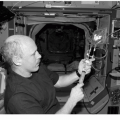The Practice of International Aerospace Medicine
Claude Thibeault
So, may it be; let us hope that the advent of a successful flying machine, now only dimly foreseen and nevertheless thought possible, will bring nothing but good into the world; that it shall abridge distance, make all parts of the globe accessible, bring men into closer relation with each other, advance civilization, and hasten the promised era in which there shall be nothing but peace and goodwill among men.
—Octave Chanute, 1894
The practice of aviation medicine has followed the evolution of aviation over the years. From the birth of aviation, a medical component was first added to military operations, followed by a commercial component and finally a space component. Eventually aerospace medicine was accepted to represent all practitioners in this field whether their activities included the space component or not. Because of the international nature of the subject, the aerospace medicine practitioner, also often referred to as an aviation medical examiner (AME) (civilian) or flight surgeon (military, space agencies), has many interactions in the international arena. However, there has never been a formally recognised “International Aerospace Medicine Specialist” per se or, probably, will there ever be. It is more appropriate to indicate that a number of aerospace medicine practitioners have an impact in the international arena by virtue of their positions in influential international organizations. However, there is little doubt that these aerospace medicine practitioners work in a unique practice environment.
The other important aspect that has particularly affected this practice environment is the evolution of aerospace medicine itself. Although the initial and only objective of the early flight surgeon was to support the flyers (pilots), that objective has been expanded significantly over the years and particularly since the last publication of this textbook.
The aim of this chapter is to briefly describe the evolution of some of the international organizations involved in aviation and how that evolution has impacted on the aerospace medicine practice of medical practitioners that belong to or work for those organizations. When appropriate, some detailed activities of these organizations will be described. Although the World Health Organization (WHO) is not directly involved in aviation, it will take an important place in this chapter and its regulations will be reviewed because public health can have a major impact on aviation operations.
INTERNATIONAL CIVIL AVIATION ORGANIZATION
Parallel to the development of aviation, it is in general and commercial aviation that we see the first attempt at international medical cooperation. From a medical practitioner standpoint, it all started with the International Commission for Air Navigation (ICAN), the predecessor of the International Civil Aviation Organization (ICAO).
Pre-1944
The first successful manned balloon crossing of the English Channel was accomplished by an Englishman in 1785 and began to set the stage for early territorial concerns about aerial navigation. However, the first recorded international powered flight, made by Louis Blériot across the English
Channel in his 25 horsepower monoplane in 1909, certainly hastened the need for international air navigation agreements between nations. In 1910, the French government invited 21 European states to meet in Paris to address air navigation issues within Europe. The conference met for 6 weeks but other fundamental navigational issues took precedence over the development of international medical standards during these sessions.
Channel in his 25 horsepower monoplane in 1909, certainly hastened the need for international air navigation agreements between nations. In 1910, the French government invited 21 European states to meet in Paris to address air navigation issues within Europe. The conference met for 6 weeks but other fundamental navigational issues took precedence over the development of international medical standards during these sessions.
The outbreak of World War I in 1914 accelerated the national military requirements for aviation medical standards, and temporarily eliminated the possibility of international cooperation. However, by the end of the war in 1918, as aviation activities were increasing rapidly in many countries, nations again recognized the need for international cooperation in matters of air navigation. The French government organized the Paris Peace Conference during the period 1919 to 1920, in which 32 allied and associated states met to draw up a peace agreement. Out of this came several treaty pacts with various nations, incorporating the Constitution of the international organization, which became known as the League of Nations. During these proceedings, on October 13, 1919, the Aeronautical Commission was formed, with members from Belgium, Bolivia, Brazil, the British Empire, Cuba, France, Greece, Italy, Japan, Portugal, Romania, the Kingdom of the Serbs, Croats and Slovenes, Siam, and the United States, and the resulting International Air Convention was eventually ratified by 38 states. This led to the formation of the permanent ICAN within the League of Nations. During the first session of the ICAN, held in Paris during July 11 to 28, 1922, a Medical Subcommission (comprising Colonel Heald, British Empire, and Dr. Garseau, France) was formed to deal with “Settlement of the rules of Annex E, as provided for in Article 13 of the Convention, of the medical examination and the minimum standard of requirements” (1). The Medical Subcommission’s work was deferred to the second session of the ICAN, which took place during October 25 to 27, 1922, in London, the United Kingdom, when the medical resolution, No. 35, was adopted, outlining requirements of mental and physical fitness for “a pilot, navigator, engineer, or member of the operating crew of aircraft engaged in public transport” (2).
The ICAN Secretariat was located in Paris, while meetings were rotated through Brussels, London, Paris, and Rome. Between 1922 and 1926, ICAN organized regular meetings, revised and updated annexes to the Convention, and distributed and coordinated air navigation information to the contracting states. However, weighted voting given to alliances formed during World War I created differences among participating states, and in spite of amendments to rectify the inequalities, the much-needed unity began to weaken (3). Although by 1933 there were 53 member states within the League of Nations, maintaining and attracting other members became increasingly difficult. Although U.S. President Woodrow Wilson himself strongly supported the League of Nations, the U.S. Senate did not, and the United States did not ratify the Paris Convention, in spite of early active participation. Further, Russia and Germany did not participate in the Paris Convention. Germany later joined the League of Nations, in 1926, but withdrew membership, along with Japan in 1933, whereas Russia did not join until 1934. Spain, unhappy with the inequality of contracting states in ICAN, held its own Ibero-American Air Convention in Madrid in 1926, inviting the Latin American and Caribbean countries, and Portugal (3). Therefore, by the early 1930s ICAN was losing its effectiveness in maintaining a spirit of international cooperation concerning air navigational matters. The hostilities that developed between nations resulting in World War II thwarted further activities of ICAN, and the office was eventually closed when Paris was invaded in 1940.
Chicago Convention (1944)
Between, during, and immediately after both World Wars, aviation experienced remarkable growth and technologic advancement, requiring nations to develop their own medical standards to reduce aviation casualties resulting from medical inaptitude or incapacitation. After World War I, utilizing military aviation medical standards as a foundation, civilian medical standards for aviation personnel made their first appearance in several countries, such as the United States, the United Kingdom, France, and Germany. By the end of World War II, larger aircraft were capable of carrying passengers and cargo internationally over long distances and the need for coordinated international air navigation agreements between nations became urgent. Therefore, the U.S. government began to study postwar aviation problems in 1943, and after initial discussions with several countries realized that aviation issues could be solved only with international cooperation. President Franklin D. Roosevelt authorized invitations to 55 countries to attend an international conference in November 1944 on civil aviation matters in Chicago, and the resulting “Convention on International Civil Aviation” came to be known as the Chicago Convention. In spite of immediate postwar political differences, 52 to 55 invited foreign states attended and worked tirelessly, especially in the technical field, to set down rules and regulations, known as Standards, regarding air navigation, to be applied uniformly and internationally in all states that signed the Convention. At the conclusion of the 37-day conference, 32 states signed the Convention, agreeing to establish the ICAO. This organization would not, however, become official until 26 states had ratified the Convention. To allow other participating states time for this, the conference had signed an Interim Agreement, which allowed for the creation of the “Provisional International Civil Aviation Organization” (PICAO), which operated from August 1945 to April 1947. On April 4, 1947, after the 26 states signed the Convention, ICAO became a reality, and Montreal, Canada was chosen as its headquarters, where it is to be found today. As ICAO became firmly established, the ICAN member states agreed to dissolve ICAN, and the former General Secretary of ICAN, Dr. Albert Roper, from France, was elected the first Secretary General of ICAO. To further enhance the international spirit of cooperation, ICAO became a specialized agency of the United Nations (UN), which had been established in October 1945.
Currently, in 2007, there are 189 contracting states of ICAO, continually working toward harmony in global air navigation issues, making ICAO one of the major UN agencies. ICAO‘s structure has a sovereign body, the Assembly, comprising representatives from all contracting states, and a governing body, the Council, which consists of 36 states elected by the Assembly for a 3-year term. The chief officers of ICAO are the President of the Council and the Secretary General, the latter having responsibility for the several hundred international civil servants working permanently at ICAO, known as the Secretariat. The Assembly meets at least once in 3 years at its headquarters in Montreal. To facilitate its activities worldwide, ICAO has divided the world into seven regions, with offices located in Bangkok, Cairo, Dakar, Lima, Mexico City, Nairobi, and Paris.
One of the primary tasks of ICAO is to continually review and revise the “Standards and Recommended Practices” (SARPs) contained in the 18 Annexes to the Chicago Convention of 1944. For safety or regularity of international air navigation, the Standards are mandatory for the member states, although a state may decide to file a difference (notifying ICAO that it will not implement the standard in question) because it may not be possible to implement a particular standard in that state’s current environment. A recommended practice is not mandatory but is “desirable” in the interest of safety, regularity, or efficiency of international air navigation.
In January 1999, ICAO launched its “Universal Safety Oversight Audit Programme” (USOAP), a precedent-setting task, with the goal of auditing all contracting states to ensure the uniform application of SARPs, to be completed by 2001 (4). Since then, audit of states against ICAO SARPs has become a vital part of ICAO‘s activities. In 2008, ICAO intends to publish the results of such audits, although many states already do this, on a voluntary basis.
Within the permanent Secretariat of ICAO, and located in the Air Navigation Bureau, headed by an aerospace medicine specialist, is the Aerospace Medicine Section, where the relevant health and safety issues relating to the human element associated with aviation are researched, studied, and debated internationally. When agreement has been reached, new medical SARPs are published, or existing ones are updated. Until recently, these health and safety issues were largely limited to pilots, engineers, navigators, and air traffic controllers. Indeed, one of the section’s primary responsibilities was, and remains, the continual reviewing and updating of the medical aspects of Annex 1 to the Chicago Convention (Personnel Licensing), Chapter 6, which contains the medical licensing requirements for aviation personnel, and reviewing and revising the “Manual of Civil Aerospace Medicine” (5) that provides supporting guidance material.
In the last 3 years, two important events modified the approach of ICAO and its Aerospace Medicine Section. First of all, in 2004, ICAO initiated an extensive review of the medical aspects of Annex 1 of the Convention, which had no major review for many years. The review itself is not a significant event because it is a primary function of the organization as mentioned earlier. However, the approach and the recommendations will change ICAO‘s future functioning. Instead of limiting itself to its own Aerospace Medicine Section, ICAO created a working group of aerospace medicine specialists from several member states and from several international aviation organizations. In the last decade or so, the model had been used on a small scale before and had generated a useful publication, the “Manual on Prevention of Problematic Use of Substances in the Aviation Workplace” (6). After approving the recommended major changes to the Annex, the ICAO Council advised that the working group should meet more frequently to keep pace with the rapid evolution of scientific data and avoid the need for infrequent, and therefore major, revisions in the future.
The other significant event also took place in 2004. Prompted by the recommendations of the Air Passenger Health Issues Working Group of the European Civil Aviation Conference (ECAC), the ICAO Assembly decided to include passenger health in its definition of safety. In October 2004, the Assembly declared “that the protection of the health of passengers and crew on international flights is an integral element of safe air travel and that conditions should be in place to ensure its preservation in a timely and cost-effective manner.” The Assembly requested the Council to:
“review existing SARPs related to passenger and crew health and develop new SARPs where appropriate with due consideration of global health issues and recent developments in air transport operations
establish suitable institutional arrangements to coordinate efforts by contracting states and other members of the international civil aviation community aimed at protecting the health of passengers and crew
develop Standards and Recommended Practices in the appropriate Annexes of the Convention in order to address contingency plans to prevent the spread of communicable diseases by air transport
support further research on the consequence of air transport on the health of passengers and crews
report on the implementation of this resolution in all aspects to the next ordinary Session of the Assembly” (7)
In 2005, ICAO established an international working group to address the immediate threat of a human influenza pandemic to the aviation industry, its workers, and the traveling public. At the time, ICAO member states were requesting advice from ICAO regarding planning for such an event and it was apparent that ICAO was best placed to coordinate the aviation response. The working group was formed from representatives of the WHO, with technical assistance from the U.S. Centers for Disease Control and Prevention (CDC), a representative of Airport Council International (ACI) and one from the International Air Transport Association (IATA), together with other representatives from several ICAO member states, particularly from Asia, as that region had been most affected by the outbreak of severe acute respiratory syndrome (SARS) in 2003 (and therefore had experience of the need for pandemic planning) and was most at risk from an outbreak of human pandemic influenza.
Two aerospace medicine specialists and another physician with extensive aviation industry knowledge were among the representatives.
Two aerospace medicine specialists and another physician with extensive aviation industry knowledge were among the representatives.
The outcome of the working group was the publication of “Guidelines for States Concerning the Management of Communicable Disease Posing a Serious Public Health Risk” (8). These guidelines include sections on general preparedness, airport preparedness, and airline preparedness.
As the activity given in the preceding text was going on, ICAO was also involved in the WHO “Informal Working Group for the Implementation of the International Health Regulations (IHR) (2005)”. As this subject will be discussed in further detail in the subsequent text, suffice to say that the participation of ICAO in this endeavor facilitated the first task of the working group, which was to comment on the proposed update of the IHR, and was particularly significant in the second task, which was to develop guidelines to assist states to implement the IHR in the different modes of transportation.
Because the IHR refers to the ICAO document “Aircraft General Declaration: Health Part,” ICAO‘s Chief of the Aerospace Medicine Section initiated, in cooperation with the ICAO Facilitation Section, a review of Annex 9 to the Chicago Convention, in which the Aircraft General Declaration can be found. This review was carried out with unusual rapidity. The major new positions and/or changes to Annex 9 are the following:
a new Standard for member States to establish a national aviation preparedness plan
requirement for first aid provision at airports upgraded from a Recommended Practice (desirable) to a Standard (mandatory)
pilot in command (PIC) to inform air traffic control of suspected communicable disease on board (previously to “notify health authorities” without specifying the mechanism, which has been found by experience to be unreliable)
revised list of signs and symptoms indicative of a communicable disease on health part of aircraft general declaration
recommendation to use the new Passenger Locator Card (PLC) for improved passenger contact tracing in the event of a suspected contact with a sick traveler
As follow-on to the ICAO communicable disease planning guidelines, and to facilitate a harmonized response by the aviation sector to any pandemic, ICAO, assisted by international experts in aerospace medicine, developed project CAPSCA (Co-operative Arrangement for the Prevention of Spread of Communicable Diseases through Air Travel). This project is centered in Asia and aims to reduce the risk of spreading influenza having pandemic potential, and similar communicable diseases, by air travellers through cooperative arrangements between participating states/administration and airports. As part of the project, an ICAO expert qualified in aerospace medicine and provided for the project will visit the participating airports to assist the concerned authorities in implementing the guidelines. Another important goal of the project is to establish an expert group (Regional Aviation Medicine Team) that can provide ongoing guidance to all states/administrations in the region. The first training workshop took place in Singapore in late 2006 and there were 25 participants from the following organizations and states/administrations: ICAO, WHO, CDC, ECAC, IATA, ACI, the United States, Hong Kong, Macao, Thailand, Malaysia, Philippines, Republic of Korea, New Zealand, and Singapore. As the project was successfull in Asia, a similar one was started in Africa with an aerospace medicine seminar held in Libreville, Gabon. It was followed in March 2008 by two workshops, one in Dakar, Senegal and one in Nairobi, Kenya. At these workshops, two Regional Aviation Medicine Teams were formed.
The role of the ICAO Aerospace Medicine Section also involves monitoring recent developments in aerospace medicine internationally, to provide guidance to licensing authorities on all operational aeromedical issues with emphasis on aeromedical training and the dissemination of information through worldwide ICAO regional civil aerospace medicine seminars, and by holding ICAO update sessions in conjunction with international aerospace medicine congresses and scientific meetings.
The description given in the preceding text gives a clear example of the practice of aerospace medicine in an international setting, a unique practice environment. A few other examples will be described later.
WORLD HEALTH ORGANIZATION
At present, there is no aerospace medicine specialist working for the WHO. However, as mentioned in the introduction and as was seen in the previous section, the WHO can have a major impact on the aviation industry through a number of its activities. It is therefore important to briefly describe those activities and recognize the interfaces between the WHO and the other international bodies involved in aviation, and where the aerospace medicine specialist may be involved.
Stay updated, free articles. Join our Telegram channel

Full access? Get Clinical Tree







